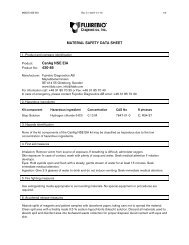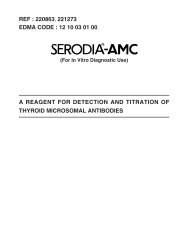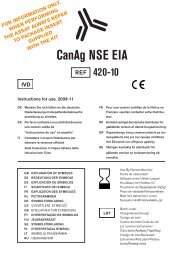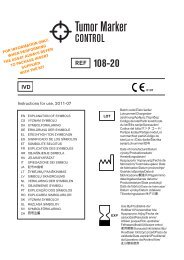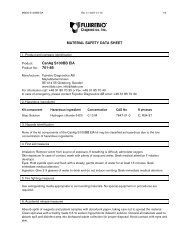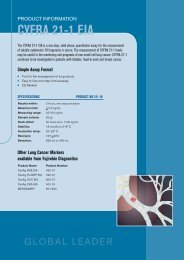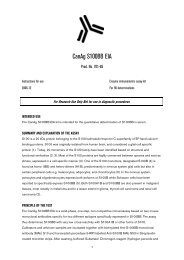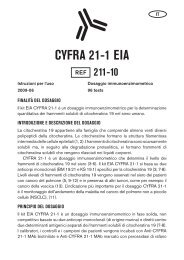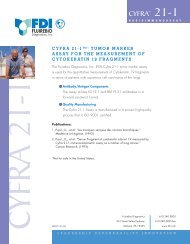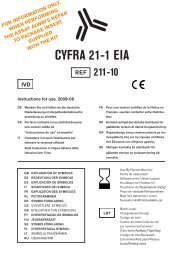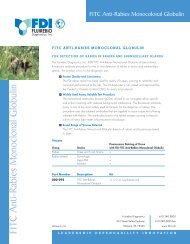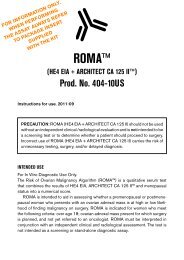canag ca242 eia - full package insert - Fujirebio Diagnostics, Inc.
canag ca242 eia - full package insert - Fujirebio Diagnostics, Inc.
canag ca242 eia - full package insert - Fujirebio Diagnostics, Inc.
You also want an ePaper? Increase the reach of your titles
YUMPU automatically turns print PDFs into web optimized ePapers that Google loves.
FOR INFORMATION ONLY.<br />
WHEN PERFORMING<br />
THE ASSAY ALWAYS REFER<br />
TO PACKAGE INSERT<br />
SUPPLIED<br />
WITH THE KIT<br />
IVD<br />
CanAg CA242 EIA<br />
REF<br />
101-10<br />
Instructions for use. 2009-06<br />
DE Wenden Sie sich bitten an die deutsche<br />
Niederlassung um die geltende Gebrauch s<br />
anweisung zu erhalten.<br />
ES Por favor contacte con su distribuidor para<br />
una versión válida de<br />
“Instrucciones de uso” en español<br />
IT Contattare il proprio Distributore per<br />
ottenere la versione ufficiale<br />
della traduzione in lingua Italiana delle<br />
Istruzioni per l’Uso<br />
FR Pour une version certifiée de la Notice en<br />
Français, veuillez contacter votre Distributeur.<br />
DK Kontakt venligst den danske distributør for<br />
gældende version af dansk brugsanvisning.<br />
GR Παρακαλούµε όπως επικοινωνήσετε µε τον<br />
προµηθευτή σας για την έγκυρη απόδοση<br />
στα Ελληνικά των οδηγιων χρήσης<br />
SE Vänligen kontakta Er distributör för<br />
gällande version av bruksanvisning på<br />
svenska.<br />
GB EXPLANATION OF SYMBOLS<br />
DE BEDEUTUNG DER SYMBOLE<br />
ES Explicación de símbolos<br />
IT SIGNIFICATO DEI SIMBOLI<br />
FR EXPLICATION DES SYMBOLES<br />
NL PICTOGRAMMEN<br />
DK SYMBOLFORKLARING<br />
CS vysvětlení symbolů<br />
GR ΕΠΕΞΗΓΗΣΗ ΤΩΝ ΣΥΜΒΟΛΩΝ<br />
PT Interpretação de símbolos<br />
HU JELMAGYARÁZAT<br />
SE SYMBOLFÖRKLARING<br />
PL INTERPRETACJA SYMBOLI<br />
LT SimboLIŲ paaiškinimai<br />
RU Обоначения<br />
Use By/Verwendbar bis/<br />
Fecha de caducidad/<br />
Utilizzare entro/Utiliser jusque/<br />
Houdbaar tot/Holdbar til/<br />
Použitelné do/Ημερομηνία λήξης/<br />
Prazo de validade/Felhasználható<br />
Bäst före datum/Użyć przed/<br />
Sunaudoti iki/Использовать до<br />
Batch code/<br />
Chargenbezeichnung/<br />
Codigo de lote/<br />
Codice del lotto/Code du lot/<br />
Lot nummer/Lotnummer/<br />
Číslo šarže/Αριθμός Παρτίδας/<br />
Código do lote/Sarzsszám<br />
Lotnummer/Kod partii/Partijos<br />
kodas/Номер лота<br />
1
REF<br />
Date of manufacture/<br />
Herstellungsdatum/<br />
Fecha de fabricación/<br />
Data di fabbricazione/<br />
Date de fabrication/<br />
Produktie datum/Produktionsdato/<br />
Datum výroby/Ημερομηνία<br />
Παραγωγής/Data de fabrico/<br />
Gyártás időpontja/Tillverkningsdatum/<br />
Data produkcji/Pagaminimo data/<br />
Дата производства<br />
Catalogue number/Bestellnummer/<br />
Número de catálogo/<br />
Numero di catalogo/Référence du<br />
catalogue/Catalogus nummer/<br />
Katalognummer/Katalogové číslo/<br />
Αριθμός καταλόγου/<br />
Referência de catálogo/<br />
Katalógusszám/Produktnummer/<br />
Numer katalogowy/Katalogo numeris/<br />
Номер по каталогу<br />
Manufacturer/Hersteller/Fabricante/<br />
Fabbricante/Fabricant/Fabrikant/<br />
Producent/Výrobce/Kτασκευαστής/<br />
Fabricante/Gyártó/Tillverkare/<br />
Producent/Gamintojas/<br />
Производитель<br />
Contains sufficient for tests/<br />
Inhalt ausreichend für Prüfungen/<br />
Contenido suficiente para <br />
ensayos/Contenuto sufficiente per<br />
“96” saggi/Contenu suffisant pour<br />
“96” tests/Inhoud voldoende voor “96”<br />
testen/Indeholder tilsttrækkeligt<br />
til ”96” test/Lze použit pro testů/<br />
Περιεχόμενο επαρκές για «96»<br />
εξετάσεις/Conteúdo suficiente para<br />
“96” ensaios/A doboz tartalma <br />
vizsgálat elvégzéséhez elegendő/<br />
Innehåller tillräckligt till “96” antal tester/<br />
Wystarczy na wykonanie testów/<br />
Turinys skirtas atlikti tyrimus<br />
/Содержит достаточные количества<br />
для «96» определений<br />
2 o C<br />
IVD<br />
8 o C<br />
In Vitro Diagnostic Medical Device/<br />
In Vitro Diagnostikum/Producto<br />
sanitario para diagnóstico in vitro/<br />
Dispositivo medico-diagnostico in vitro/<br />
Dispositif médical de diagnostic in vitro/<br />
Medisch hulpmiddel voor in-vitro<br />
diagnostiek/Medicinsk udstyr til in<br />
vitro-diagnostik/In Vitro diagnostický<br />
zdravotnický prostředek /<br />
In Vitro Διαγνωστικό Ιατροτεχνολογικό<br />
προϊόν/Dispositivo médico para<br />
diagnóstico in vitro/In vitro<br />
diagnosztikum/Endast för in vitrodiagnostik/Wyrób<br />
do diagnistyki In<br />
Vitro/In Vitro Diagnostinė Medicinos<br />
Priemonė/Только для диагностики<br />
In Vitro<br />
Temperature limitation/<br />
Temperaturbegrenzung/<br />
Límite de temperatura/<br />
Limiti di temperatura/<br />
Limites de température/<br />
Temperatuurlimiet/<br />
Temperaturbegrænsning/<br />
Teplotní rozmezí od do/<br />
Περιορισμοί θερμοκρασίας/<br />
Limites de temperatura/<br />
Hőmérséklettartomány/<br />
Temperaturbegränsning/<br />
Przestrzegać zakresu temperatury/<br />
Temperatūriniai apribojimai/<br />
Температурный режим<br />
Consult Instructions for Use/<br />
Gebrauchsanweisung beachten/<br />
Consulte las instrucciones de uso/<br />
Consultare le istruzioni per l‘uso/<br />
Consulter les instructions d‘utilisation/<br />
Raadpleeg de gebruiksaanwijzing/<br />
Se brugsanvisning/Viz návod k<br />
použití/Συμβουλευτείτε τις οδηγίες<br />
χρήσης/Consulte as instruções de<br />
utilização/Nézze meg a Használati<br />
utasítást/Se bruksanvisning/Sprawdź<br />
w instrukcji obsługi/Dėl naudojimo<br />
žiūrėkite instrukcijas/<br />
Обратитесь к инструкции по<br />
применению<br />
2
CONT<br />
Biological risks/Biogefährdung/<br />
Riesgo biológico/Rischio biologico/<br />
Risques biologiques/Biologisch<br />
risico/Biologisk fare/<br />
Biologicky nebezpečné<br />
Βιολογικοί κίνδυνοι/Risco biológico<br />
Biológiai kockázat/Biologisk risk/<br />
Ryzyko biologiczne/Biologinis pavojus/<br />
Биологическая опасность<br />
Contents of kit/Inhalt/Contenido/<br />
Contenudo/Contenu/Indhold/<br />
ανιδραστήρια/Kit innehåll/<br />
Rinkinio turinys/<br />
Компоненты набора<br />
ORIG MOU<br />
ORIG HUM<br />
From mouse/der Maus/de ratón/<br />
Murino/De souris/Mus/απο ποντίκι/<br />
Från mus/Pelės kilmės/<br />
Мышиного происхождения<br />
Human/Human/Humano/<br />
Origine Umana/Humaine/Human<br />
δείγματα αναφοράς/Human/<br />
Žmogaus kilmės/<br />
Человеческого происхождения<br />
WARNINGS AND PRECAUTIONS<br />
For in vitro diagnostic use<br />
• For Professional Use Only<br />
• Please refer to the U.S. Department of Health and Human Services (Bethesda, Md., USA) publication No.<br />
(CDC) 88—8395 on laboratory safety procedures or any other local or national regulation.<br />
• Handle all patient specimens as potentially infectious.<br />
• Reagents contain sodium azide (NaN 3<br />
) as a preservative. Sodium azide may react with lead and copper<br />
plumbing to form highly explosive metal azides. On disposal, flush with a large volume of water to prevent<br />
azide build-up.<br />
• Follow local guidelines for disposal of all waste material.<br />
Caution<br />
Material used in the preparation of human source reagent has been tested and found to be Non Reactive for HIV<br />
1 and 2 Antibody, HCV Antibody and Hepatitis B Surface Antigen (HBsAg). Since no method can completely<br />
rule out the presence of blood borne diseases, the handling and disposal of human source reagents from this<br />
product should be made as if they were potentially infectious.<br />
WARNHINWEISE UND VORSICHTSMASSNAHMEN<br />
DE<br />
Für In-vitro-Diagnostik<br />
• Nur für geschultes Fachpersonal.<br />
• Bitte beachten Sie die Vorschriften zur Laborsicherheit in der Publikation Nr. (CDC) 88-8395 des<br />
US Department of Health and Human Services (Bethesda, MD, USA) oder andere gleichwertige regionale<br />
oder nationale Bestimmungen.<br />
• Alle Patientenproben gelten als potenziell infektiös und sind entsprechend zu handhaben.<br />
• Die Reagenzien enthalten Natriumazid (NaN 3<br />
) als Konservierungsmittel. Natriumazid kann mit Blei- und<br />
Kupferleitungen reagieren und hochexplosive Metallazide bilden. Spülen Sie die Leitungen beim Wegschüt<br />
ten mit viel Wasser, um einer Azidbildung vorzubeugen.<br />
• Befolgen Sie die lokalen Richtlinien zur Entsorgung von anfallenden Abfallstoffen.<br />
Achtung<br />
Das zur Herstellung der Reagenzien aus humaner Quelle verwendete Material wurde auf HIV-1/2-Antikörper,<br />
HCV-Antikörper und Hepatitis-B-Oberflächenantigen (HBsAg) getestet und als nicht reaktiv befunden. Da es<br />
keine Methode gibt, mit der das Vorliegen von durch Blut übertragenen Krankheiten vollkommen ausgeschlossen<br />
werden kann, sollten der Umgang mit Reagenzien aus humaner Quelle und deren Entsorgung so erfolgen, als<br />
handele es sich um potenziell infektiöses Material.<br />
GB<br />
3
CUIDADOS Y PRECAUCIONES<br />
ES<br />
Para diagnóstico in vitro<br />
• Solo para uso profesional<br />
• Consultar la publicación del U.S. Department of Health and Human Services (Bethesda, Md., USA)<br />
publication No. (CDC) 88—8395 o las normas locales o nacionales.<br />
• Tratar todas las muestras de pacientes como potencialmente infecciosas.<br />
• Los reactivos contienen azida sódica (NaN 3<br />
) come conservante. La azida sódica puede reaccionar con el<br />
plomo o el cobre de las tuberías, formando azidas metálicas muy explosivas. Al limpiar los reactivos, dejar<br />
correr gran cantidad de agua para evitar la formación de azidas.<br />
• Todos los residuos se deben tirar cumpliendo las normas en vigor.<br />
Precaución<br />
Material usado en la preparación de este reactivo se analizó la presencia de anticuerpos HIV 1 y 2, anticuerpos<br />
HCV y antigenos de superficie de hepatitis B, siendo el resultado de dichos análisis negativo. Sin embargo, como<br />
el test no puede excluir completamente los anticuerpos HIV 1 y 2, anticuerpos HCV y antigenos de superficie de<br />
hepatitis B, el manejo y disposición del reactivo debe ser como potencialmente infecciosas.<br />
AVVERTENZE E PRECAUZIONI<br />
Per uso diagnostico in vitro<br />
• Solamente per uso professionale<br />
• Come riferimento si consiglia la pubblicazione No. ( CDC ) 88-8395 del US Department of Health and<br />
Human Service o qualsiasi altro regolamento locale o nazionale relativo alle Norme di Sicurezza da seguire<br />
nei Laboratori Diagnostici<br />
• Maneggiare I campioni dei pazienti come potenzialmente infetti<br />
• I reattivi contengono sodio azide ( NaN3) come conservante. Il sodio azide può reagire con piombo e rame<br />
formando azidi metallici altamente esplosivi. Quando i reattivi vengono scartati lavare con abbondante<br />
quantità di acqua per prevenire il rischio di reazione dell’azide<br />
• Seguire le normative vigenti relative all’eliminazione del materiale usato<br />
Precauzioni<br />
Le sostanze usate nella preparazione di reattivi di origine umana sono state testate e trovate Non Reattive per<br />
l’anticorpo anti-HIV 1/2, l’anticorpo anti-HCV e per l’antigene di superficie dell’Epatite B ( HBsAg). Tuttavia poichè<br />
nessun metodo diagnostico è in grado di escludere completamente patologie correlate alla presenza di questi<br />
anticorpi ed antigeni, la manipolazione e lo scarto dei reattivi di origine umana di questo prodotto, deve essere<br />
effettuata come se essi fossero potenzialmente infettivi.<br />
PRÉCAUTIONS D’EMPLOI ET MISE EN GARDE<br />
FR<br />
Pour un usage diagnostic in Vitro<br />
• Pour usage professionnel seulement.<br />
• Prière de se référer à la Publication N°: (CDC) 88-8395 de l’U.S. Départment of Health and Human Services<br />
(Béthesda, Md., USA) sur les procédures de sécurité dans les laboratoires ou toutes autres réglementations<br />
locales et nationales.<br />
• Manipuler les échantillons de patients comme potentiellement infectieux.<br />
• Réactifs contenant de l’Azide de Sodium (NaN3) comme conservateur: l’Azide de Sodium peut réagir avec<br />
les tubes en plomb et en cuivre pour former des Azides de métaux hautement explosifs. Lors de<br />
l’élimination, répandre une grande quantité d’eau pour prévenir la formation des Azides.<br />
• Suivre les réglementations locales pour l’élimination et le traitement de tous les déchets.<br />
Attention<br />
Le materiel utilisé pour la préparation de réactifs d’origine humaine, a été testé et trouvé non réactif aux Anticorps<br />
anti-virus de l’immunodéficience humaine (VIH-1/2), aux Anticorps de l’Hépatite C (VHC) et à l’Antigène de surface<br />
de l’Hépatite B (AgHBs). Puisqu’il n’existe pas de méthode de test, rejetant complètement la présence de maladies<br />
dans le sang, la manipulation et l’élimination de réactifs d’origine humaine doivent être effectuées comme s’ils<br />
étaient potentiellement infectieux.<br />
4<br />
IT
ADVARSLER OG FORHOLDSREGLER<br />
DK<br />
Til in vitro diagnostisk anvendelse<br />
• Kun til professionel brug<br />
• Der henvises til U.S. Department of Health and Human Services (de amerikanske sundhedsmyndigheder)<br />
(Bethesda, Md., USA) udgivelse nr. (CDC) 88-8395 vedrørende laboratoriesikkerhedsprocedurer eller<br />
andre lokale eller nationale forskrifter.<br />
• Alle patientprøver skal behandles som potentielt smittefarlige.<br />
• Reagenser indeholder natriumazid som præserveringsmiddel. Natriumazid kan danne eksplosive syrer i<br />
metalafløb. Anvend korrekt affaldsprocedure.<br />
• Følg lokale regler for afskaffelse af alt affald.<br />
Advarsel<br />
Alt materiale anvendt ved beredningen af reagenser af human oprindelse er blevet testet og fundet negative for HIV<br />
1 og 2 antistoffer, HCV antistoffer og Hepatitis B overflade antigen (HbsAg). Da ingen analysemetoder fuldstændig<br />
kan udelukke tilstedeværelsen af blodbårne sygdomme, skal håndtering og bortskaffelse af reagenser af human<br />
oprindelse fra dette produkt behandles som potentielt smittefarligt.<br />
ΠΡΟΕΙΔΟΠΟΙΗΣΕΙΣ ΚΑΙ ΠΡΟΦΥΛΑΞΕΙΣ<br />
GR<br />
Για in vitro διαγνωσική χρήση<br />
• Για επαγγελµατική χρήση, µόνο.<br />
• Παρακαλούμαι όπως επικαλεστείτε τις οδηγίες ασφαλούς λειτουγίας των εργαστηρίων του Τμήματος<br />
Υγείας και Ανθρωπινων Υπηρεσιών των Η.Π.Α.(U.S. Department of Health and Human Services)<br />
(Bethesda, Md., USA) αριθμός έκδοσης (CDC) 88—8395, ή οποιοδήποτε άλλο κατά τόπους σχετικό<br />
Εθνικό κανονισμό.<br />
• Μεταχειριστήτε όλα τα δείγματα ως μολυσμένα.<br />
• Αποφύγετε επαφή με αντιδραστήρια που περιέχουν υπεροξείδιο του υδρογόνου ή υδροχλωρικό οξύ.<br />
Σε περίπτωση επαφής με τέτοιου είδους αντιδραστήρια, πλυθείτε σχολαστικά με άφθονο νερό.<br />
• Ακολουθείστε τις κατά τόπου οδηγίες για απομάκρυνση άχρηστου υλικού.<br />
Προσοχή<br />
Ολα τα υλικά που χρησιµοποιούται για την παρασκευή αντιδραστηρίων ανθρώπινης προέλευσης έχουν<br />
εξετασθεί και έχουν ßρεθεί αρνητικά για HIV-1/2 Αντίσωµα (Ab), HCV Αντίσωµα (Ab) και Ηπατίτιδας B<br />
Αντιγόνο Επιφανειας (Hepatitis B Surface Antigen) (HBsAg). Εφ΄όσον δεν υπάρχει µέθοδος ικανή να αποκλείσει<br />
απόλυτα την παρουσία αιµατολογικών / µολυσµατικών ασθενειών, ο τρόπος µεταχείρισης και η αποµάκρυνση<br />
αντιδραστηρίων ανθρώπινης προέλευσης αυτού του συγκεκριµένου προίοντος, πρέπει να είναι ίδιος µε αυτόν<br />
που ακολουθείται για µολυσµένα δείγµατα.<br />
VARNINGAR OCH SÄKERHETSÅTGÄRDER<br />
Endast för in vitro diagnostik<br />
• Endast för professionellt bruk<br />
• Följ “U.S. Department of Health and Human Services (Bethesda, Md., USA) publikation (CDC) 88—8395”<br />
eller annan lokal eller nationell bestämmelse beträffande laboratoriesäkerhet.<br />
• Hantera alla patientprover som potentiellt smittsamma.<br />
• Vissa reagens innehåller natriumazid (NaN 3<br />
) som konserveringsmedel. Natriumazid kan reagera med blyoch<br />
kopparledningar och bilda explosiva metall-azider. Använd rikligt med vatten vid nedspolning i avloppet<br />
för att förhindra metall-azid bildning.<br />
• Följ lokala bestämmelser för bortskaffande av avfall.<br />
Varning<br />
Material som använts för tillverkning av reagens med humant ursprung har testats och befunnits negativt för HIV 1<br />
och 2 antikroppar, HCV antikroppar samt hepatit B ytantigen (HBsAg). Eftersom inget test <strong>full</strong>ständigt kan utesluta<br />
ev. närvaro av blodsmitta skall hantering och bortförskaffande av humant material från denna produkt ske som om<br />
den vore potentiellt infektiös.<br />
SE<br />
5
CanAg CA242 EIA<br />
GB<br />
Instructions for use<br />
Enzyme immunometric assay kit<br />
For 96 determinations<br />
INTENDED USE<br />
The CanAg CA242 EIA kit is intended for the quantitative determination of CA242<br />
cancer antigen in serum.<br />
SUMMARY AND EXPLANATION OF THE ASSAY<br />
The tumor marker CA242 is defined by the monoclonal antibody C242. The chemical<br />
structure of the antigenic determinant is not exactly known, but the determinant have<br />
been shown to be a sialylated carbohydrate structure. In serum, CA242 is found on<br />
the same mucin-complex as CA50 and sialylated Lewis a (CA19-9). Thus, CA242 is<br />
related, but not identical to the epitope of CA19-9 (1, 2). Serum levels of CA242 are<br />
low in healthy subjects and subjects with benign diseases, while elevated levels are<br />
commonly found in serum from patients with gastro-intestinal cancer (3).<br />
The CA242 marker may be used as an aid in the diagnosis and management of<br />
patients with known or suspected gastro-intestinal carcinomas (4-9). The CanAg<br />
CA242 EIA should not be used as a substitute for any established clinical examination<br />
of malignancy, but may be used as a complement to existing clinical and<br />
laboratory methods.<br />
PRINCIPLE OF THE TEST<br />
The CanAg CA242 EIA is a solid-phase, non-competitive immunoassay based on<br />
the direct sandwich technique. Calibrators, controls and patient samples are incubated<br />
together with biotinylated anti-CA242 monoclonal antibody (MAb) C241 in<br />
Streptavidin coated microstrips. CA242 present in calibrators, controls or samples is<br />
adsorbed to the Streptavidin coated microstrips by the biotinylated anti-CA242 MAb<br />
during the incubation. The strips are then washed and incubated with horseradish<br />
peroxidase (HRP) labelled Anti-CA242 MAb C242. After washing, buffered Substrate/<br />
Chromogen reagent (hydrogen peroxide and 3, 3’, 5, 5’ tetra-methylbenzidine) is<br />
added to each well and the enzyme reaction is allowed to proceed. During the enzyme<br />
reaction a blue colour will develop if antigen is present. The intensity of the colour<br />
is proportional to the amount of CA242 antigen present in the samples.<br />
The colour intensity is determined in a microplate spectrophotometer at 620<br />
nm (or optionally at 405 nm after addition of Stop Solution). Calibration curves are<br />
6
constructed for each assay by plotting absorbance value versus the concentration<br />
for each calibrator. The CA242 concentrations of patient samples are then read<br />
from the calibration curve.<br />
REAGENTS<br />
• Each CanAg CA242 EIA kit contains reagents for 96 tests.<br />
• The expiry date of the kit is stated on the label on the outside of the kit box.<br />
• Do not use the kit beyond the expiry date.<br />
• Do not mix reagents from different kit lots.<br />
• Store the kit at 2–8°C. Do not freeze.<br />
• Opened reagents are stable accordning to the table below provided they are<br />
not contaminated, stored in resealed original containers and handled as prescribed.<br />
Return to 2-8°C immediately after use.<br />
Component Quantity Storage and stability<br />
after first opening<br />
MICROPLA<br />
Microplate 1 Plate 2—8°C until expiry<br />
date stated on the plate<br />
12 x 8 wells coated with Streptavidin. After opening, immediately return unused strips<br />
to the aluminium pouch, containing desiccant. Reseal care<strong>full</strong>y to keep dry.<br />
CA242 Calibrators 5 vials 2—8°C until expiry<br />
date stated on the vials<br />
CAL CA242 0<br />
0 U/mL 1 x 0.75 mL<br />
CAL CA242 15<br />
CAL CA242 50<br />
CAL CA242 100<br />
15 U/mL 1 x 0.75 mL<br />
50 U/mL 1 x 0.75 mL<br />
100 U/mL 1 x 0.75 mL<br />
CAL CA242 150<br />
150 U/mL 1 x 0.75 mL<br />
Human CA242 antigen in a Tris-HCl buffered salt solution containing bovine serum<br />
albumin, an inert yellow dye, and 0.05% NaN 3<br />
as preservative. Ready for use.<br />
7
Component Quantity Storage and stability<br />
after first opening<br />
CA242 Controls 2 vials 2–8°C until expiry<br />
date stated on the vials<br />
CONTROL CA242 1<br />
1 x 0.75 mL<br />
CONTROL<br />
CA242<br />
2<br />
1 x 0.75 mL<br />
Human CA242 antigen in a Tris-HCl buffered salt solution containing bovine serum<br />
albumin, and 0.05% NaN 3<br />
as preservative. Ready for use.<br />
BIOTIN Anti-CA242<br />
Biotin Anti-CA242 1 x 15 mL 2—8°C until expiry<br />
date stated on the vial<br />
Biotin Anti-CA242 monoclonal antibody from mouse, approximately 1.5 µg/mL.<br />
Contains Tris-HCl buffered saline (pH 7.75) with bovine serum albumin, bovine<br />
immunoglobulin, blocking agents, detergent, an inert red dye and 0.05% NaN 3<br />
as<br />
preservative. Ready for use.<br />
CONJ Anti-CA242<br />
Tracer, HRP Anti-CA242 1 x 0.75 mL 2—8°C until expiry<br />
date stated on the vial<br />
Stock solution of HRP Anti-CA242 monoclonal antibody from mouse, approximately<br />
40 µg/mL. Contains preservatives. To be diluted with Tracer Diluent prior to use.<br />
DIL<br />
CONJ<br />
Tracer Diluent 1 X 15 mL 2–8° C until expiry date<br />
stated on the vial<br />
Phosphate buffered saline (pH 7.2) with bovine serum albumin, bovine immunoglobulin,<br />
blocking agents, detergent, an inert blue dye, and 0.01 % methyl-isothiazolone<br />
(MIT) as preservative. Ready for use.<br />
8
Component Quantity Storage and stability<br />
after first opening<br />
SUBS TMB<br />
TMB HRP-Substrate 1 x 12 mL 2—8°C until expiry<br />
date stated on the vial<br />
Contains buffered hydrogen peroxide and 3, 3’, 5, 5’ tetramethyl-benzidine (TMB).<br />
Ready for use.<br />
STOP<br />
STOP Solution 1 x 15 mL 2—8°C until expiry<br />
date stated on the vial<br />
Contains 0.12 M hydrochloric acid. Ready for use.<br />
WASHBUF<br />
25X<br />
Wash Concentrate 1 x 50 mL 2—8°C until expiry<br />
date stated on the bottle<br />
A Tris-HCl buffered salt solution with Tween 20. Contains Germall II as preservative.<br />
To be diluted with water 25 times before use.<br />
Indications of instability<br />
The TMB HRP-Substrate should be colourless or slightly bluish. A blue colour<br />
indicates that the reagent has been contaminated and should be discarded.<br />
WARNINGS AND PRECAUTIONS<br />
For in vitro diagnostic use.<br />
• For professional use only.<br />
• Please refer to the US Department of Health and Human Services<br />
(Bethesda, Md., US) publication No. (CDC) 88-8395 on laboratory safety or<br />
any other local or national regulation.<br />
• Handle all patient specimens as potentially infectious.<br />
• Reagents contain sodium azide (NaN 3<br />
) as a preservative. Sodium azide may<br />
react with lead and copper plumbing to form highly explosive metal azides.<br />
On disposal, flush with a large volume of water to prevent azide build-up.<br />
• Follow local guidelines for disposal of all waste material.<br />
9
Caution<br />
Material used in the preparation of human source reagent has been tested and<br />
found to be Non Reactive for HIV-1/2 Antibody, HCV Antibody and Hepatitis B<br />
Surface Antigen (HBsAg). Since no method can completely rule out the presence<br />
of blood borne diseases, the handling and disposal of human source reagents from<br />
this product should be made as if they were potentially infectious.<br />
SPECIMEN COLLECTION AND HANDLING<br />
The CanAg CA242 EIA is intended for use with serum. Collect blood by venipuncture<br />
and separate the serum according to common procedures. Samples can be<br />
stored at 2–8° C for 24 hours. For longer periods it is recommended to store the<br />
samples at –20°C or below. Avoid repeated freezing and thawing of the samples.<br />
Allow frozen samples to thaw slowly, preferably at 2–8° C over night and then bring<br />
the samples to room temperature before analysis.<br />
PROCEDURE<br />
Materials required but not supplied with the kit<br />
1. Microplate shaker<br />
Shaking should be medium to vigorous. Longitudinal shaking approximately<br />
200 strokes/min, oscillations 700-900/min.<br />
2. Microplate wash device<br />
Automatic plate wash capable of performing 1, 3 and 6 washing cycles with<br />
a minimal fill volume of 350 µL/well/washcycle.<br />
The Nunc Immuno-8 manual strip washer is recommended if an automatic<br />
microplatewash is not used.<br />
3. Microplate spectrophotometer<br />
With a wavelength of 620 nm and/or 405 nm and an absorbance range of<br />
0 to 3.0.<br />
4. Precision pipettes<br />
With disposable plastic tips to deliver microlitre and millilitre volumes.<br />
An 8-channel pipette or respenser pipette with disposable plastic tips<br />
for delivery of 100 µL is useful but not essential.<br />
5. Distilled or deionized water<br />
For preparation of Wash Solution.<br />
10
Procedural notes<br />
1. A thorough understanding of this <strong>package</strong> <strong>insert</strong> is necessary to ensure proper<br />
use of the CanAg CA242 EIA kit. The reagents supplied with the kit are intended<br />
for use as an integral unit. Do not mix identical reagents from kits having different<br />
lot numbers. Do not use the kit reagents after the expiry date printed on<br />
the outside of the kit box.<br />
2. Reagents should be allowed to reach room temperature (20–28°C) prior to<br />
use. The assay should only be performed at temperatures between 20–28°C to<br />
obtain accurate results. Frozen specimens should be brought to room temperature<br />
slowly and must be gently but thoroughly mixed after thawing.<br />
3. Before starting to pipette calibrators, controls and patient specimens it is<br />
advisable to mark the strips to be able to clearly identify the samples during<br />
and after the assay.<br />
4. The requirement for efficient and thorough washing for separation of bound and<br />
unbound antigen and reagents from the solid-phase bound antibody-antigen<br />
complexes is one of the most important steps in an EIA. In order to ensure<br />
efficient washing make sure that all wells are completely filled to the top edge<br />
with wash solution during each wash cycle, that wash solution is dispensed<br />
at a good flow rate, that the aspiration of the wells between and after the wash<br />
cycles is complete and that the wells are empty. If there is liquid left, invert the<br />
plate and tap it care<strong>full</strong>y against absorbent paper.<br />
- Automatic strip washer: Follow the manufacturer’s instructions for cleaning<br />
and maintenance diligently and wash the required number of wash cycles<br />
prior to and after each incubation step. It’s highly recommended to<br />
use strip process mode and overflow wash mode with a dispensing<br />
volume of 800 µL. The aspiration/wash device should not be left standing<br />
with the Wash Solution for long periods, as the needles may get<br />
clogged resulting in poor liquid delivery and aspiration.<br />
5. The TMB HRP-Substrate is very sensitive for contamination. For optimal stability<br />
of the TMB HRP-Substrate, pour the required amount from the vial to a care<strong>full</strong>y<br />
cleaned reservoir or preferably a disposable plastic tray to avoid contamination<br />
of the reagent. Be sure to use clean disposable plastic pipette<br />
tips (or respenser pipette tip).<br />
6. Be sure to use clean disposable plastic pipette tips and a proper pipetting<br />
technique when handling samples and reagents. Avoid carry-over by holding<br />
the pipette tip slightly above the top of the well and avoid touching the plastic<br />
strip or surface of the liquid. A proper pipetting technique is of particular<br />
importance when handling the TMB HRP-Substrate.<br />
11
Protocol Sheet<br />
REF<br />
CanAg CA242 EIA 101-10<br />
Mix the components directly before use. Use shaking conditions according to the Instructions.<br />
Step Bottle/Plate Procedure<br />
1. Prepare Wash Solution<br />
WASHBUF 25X<br />
Dilute 50 mL of Wash Concentrate with 1200 mL<br />
of distilled or deionized water.<br />
Prepare Tracer working solution<br />
CONJ<br />
DIL CONJ<br />
Anti-CA242<br />
Mix 50 µL of Tracer, HRP Anti-CA242 with 1mL of<br />
Tracer Diluent per strip:<br />
No. of Tracer, HRP Anti-CA242 Tracer Diluent<br />
Strips (µL) (mL)<br />
1 50 1<br />
2 100 2<br />
3 150 3<br />
4 200 4<br />
5 250 5<br />
6 300 6<br />
7 350 7<br />
8 400 8<br />
9 450 9<br />
10 500 10<br />
11 550 11<br />
12 600 12<br />
2. Wash<br />
MICROPLA<br />
Wash each well once with Wash Solution.<br />
Use manual or automatic washer.
3. Add calibrators, controls<br />
and samples<br />
4. Add Biotin Anti-CA242<br />
5. <strong>Inc</strong>ubate<br />
6. Wash<br />
7. Add Tracer working solution<br />
8. <strong>Inc</strong>ubate<br />
9. Wash<br />
10. Add TMB HRP-Substrate<br />
11. <strong>Inc</strong>ubate<br />
12. Read absorbance<br />
Alt.12 Add Stop Solution<br />
Alt.13 <strong>Inc</strong>ubate<br />
Alt.14 Read absorbance<br />
CAL CA242<br />
0, 15, 50, 100, 150<br />
CONTROL CA242<br />
1, 2<br />
BIOTIN<br />
Anti-CA242<br />
MICROPLA<br />
MICROPLA<br />
TRACER WORKING<br />
SOLUTION<br />
MICROPLA<br />
MICROPLA<br />
SUBS<br />
TMB<br />
MICROPLA<br />
MICROPLA<br />
STOP<br />
MICROPLA<br />
MICROPLA<br />
25 µL in each well<br />
100 µL in each well<br />
2 hours shaking at room temperature<br />
Wash each well three times with Wash Solution.<br />
Use manual or automatic washer.<br />
100 µL in each well<br />
1 hour shaking at room temperature<br />
Wash each well six times with Wash Solution.<br />
Use manual or automatic washer.<br />
100 µL in each well<br />
30 min shaking at room temperature<br />
620 nm<br />
100 µL in each well<br />
1 min shaking at room temperature<br />
Read at 405 nm within 15 min
Preparation of reagents<br />
Stability of prepared reagent<br />
Wash Solution<br />
2 weeks at 2–25°C in a<br />
sealed container<br />
Pour the 50 mL Wash Concentrate into a clean container and dilute 25- fold by<br />
adding 1200 mL of distilled or deionized water to give a buffered Wash Solution.<br />
Tracer Working Solution<br />
3 weeks at 2–8°C in a<br />
sealed container<br />
Prepare the required quantity of Tracer working solution by mixing 50 µL of Tracer,<br />
HRP Anti-CA242 with 1 mL of Tracer Diluent per strip (see table below):<br />
No. of Tracer, HRP Anti-CA242 Tracer Diluent<br />
Strips (µL) (mL)<br />
1 50 1<br />
2 100 2<br />
3 150 3<br />
4 200 4<br />
5 250 5<br />
6 300 6<br />
7 350 7<br />
8 400 8<br />
9 450 9<br />
10 500 10<br />
11 550 11<br />
12 600 12<br />
Be sure to use a clean plastic or glass bottle for preparation of the Tracer Working<br />
Solution.<br />
Alternative: Pour the content of the Tracer, HRP Anti-CA242 into the vial of Tracer<br />
Diluent and mix gently. Make sure that all of the Tracer, HRP Anti-CA242 is transferred<br />
to the vial of Tracer Diluent.<br />
NOTE: The Tracer Working Solution is stable for 3 weeks at 2–8°C. Do not prepare<br />
more Tracer Working Solution than will be used within this period and make sure<br />
that it is stored properly.<br />
14
Assay procedure<br />
Perform each determination in duplicate for calibrators, controls and patient samples.<br />
A calibration curve should be run with each assay. All reagents and samples must<br />
be brought to room temperature (20–28°C) before use.<br />
1. Start to prepare Wash Solution and Tracer Working Solution. It is important to use<br />
clean containers. Follow the instructions care<strong>full</strong>y.<br />
2. Transfer the required number of microplate strips to a strip frame. (Immediately<br />
return the remaining strips to the aluminium pouch containing a desiccant<br />
and reseal care<strong>full</strong>y). Wash each strip once with the Wash Solution. Do<br />
not wash more strips than can be handled within 30 min.<br />
3. Pipette 25 µL of the CA242 Calibrators (CAL 0, 15, 50, 100, 150), Controls<br />
(C1, C2) and patient samples (unknowns Unk) into the strip wells according<br />
to the following scheme:<br />
1 2 3 4 5 6 7 etc<br />
A Cal Cal Unk 2<br />
0 150<br />
B Cal Cal Unk 2<br />
0 150<br />
C Cal C1 etc.<br />
15<br />
D Cal C1<br />
15<br />
E Cal C2<br />
50<br />
F Cal C2<br />
50<br />
G Cal Unk 1<br />
100<br />
H Cal Unk 1<br />
100<br />
4. Add 100 µL of Biotin Anti-CA242 to each well using a 100 µL precision<br />
pipette (or an 8-channel 100 µL precision pipette). Avoid carry-over by<br />
holding the pipette tip slightly above the top of the well and avoid touching the<br />
plastic strip or the surface of the liquid.<br />
5. <strong>Inc</strong>ubate the frame containing the strips for 2 hours (± 10 min) at room temperature<br />
(20–28°C) with constant shaking of the plate using a microplate<br />
shaker.<br />
6. After the first incubation aspirate and wash each strip 3 times using the wash<br />
procedure described in Procedural notes, item 4.<br />
15
7. Add 100 µL of Tracer working solution to each well. Use the same pipetting<br />
procedure as in item 4 above.<br />
8. <strong>Inc</strong>ubate the frame for 1 hour (± 5 min) at room temperature (20–28°C) with<br />
constant shaking.<br />
9. After the second incubation aspirate and wash each strip 6 times, using the<br />
wash procedure described in Procedural notes, item 4.<br />
10. Add 100 µL of TMB HRP-Substrate to each well using the same pipetting<br />
procedure as in item 4. The TMB HRP-Substrate should be added to the<br />
wells as quickly as possible and the time between the addition to the first and<br />
last well should not exceed 5 min.<br />
11. <strong>Inc</strong>ubate for 30 min (± 5 min) at room temperature with constant shaking.<br />
Avoid direct sunlight.<br />
12. Immediately read the absorbance at 620 nm in a microplate spectrophotometer.<br />
Option<br />
If the laboratory does not have access to a microplate spectrophotometer capable<br />
of reading at 620 nm, the absorbance can be determined as follows:<br />
Alt. 12. Add 100 µL of Stop Solution. Mix and read the absorbance at 405 nm<br />
in a microplate spectrophotometer within 15 minutes after addition<br />
of Stop Solution.<br />
Measurement range<br />
The CanAg CA242 EIA measures concentrations between 1 and 150 U/mL. If CA242<br />
concentrations above the measuring range are to be expected, it is recommended to<br />
dilute samples with normal human serum prior to analysis. NOTE: The serum used<br />
for dilution must also be measured in order to determine the endogenous CA242<br />
concentration (see “Calculation of results”).<br />
Quality control<br />
CA242 Control 1 and 2 may be used for validation of the assay series. Ranges of<br />
expected results are indicated on the vial labels. If values outside of the specified<br />
range are obtained, a complete check of reagents and reader performance should<br />
be made and the analysis repeated. Each laboratory may in addition prepare its own<br />
serum pools at different levels, which can be used as internal controls in order to<br />
assure the precision of the assay.<br />
16
Reference material<br />
Since no common reference material is available for CA242 antigen, CanAg CA242<br />
EIA Calibrator values are assigned against a set of in-house reference standards.<br />
CALCULATION OF RESULTS<br />
If a microplate spectrophotometer reader with built-in data calculation program<br />
is used, refer to the manual for the plate reader and create a program using the<br />
concentration stated on the labels of each of the CA242 Calibrators.<br />
For automatic calculation of CA242 results it is recommended to use either of the<br />
following methods:<br />
• Cubic spline curve fit method. Calibrator 0 should be included in the curve<br />
with the value 0 U/mL.<br />
• Spline smoothed curve fit method. Calibrator 0 should be used as plate<br />
blank.<br />
• Interpolation with point-to-point evaluation. Calibrator 0 should be included<br />
in the curve with the value 0 U/mL.<br />
• Quadratic curve fit method. Calibrator 0 should be included in the curve with<br />
the value 0 U/mL.<br />
NOTE: 4-parametric or linear regression should not be used.<br />
For manual evaluation, a calibration curve is constructed by plotting the absorbance<br />
(A) values obtained for each CA242 Calibrator against the corresponding CA242<br />
concentration (in U/mL), see figure below. The unknown CA242 concentrations<br />
can then be read from the calibration curve using the mean absorbance value of<br />
each patient specimen.<br />
If samples in an initial analysis give CA242 levels higher than 150 U/mL, the samples<br />
should be diluted 1/10 with normal human serum and reanalysed to obtain the<br />
accurate CA242 concentration. NOTE: The sample used for dilution must also be<br />
measured in order to determine the endogenous CA242 concentration.<br />
The CA242 concentration of the undiluted sample is calculated as:<br />
Dilution 1/10: 10 x ([CA242] Diluted sample<br />
-(0.9x [CA242] Normal serum<br />
))<br />
17
Example of results<br />
Specimen Calibrator Mean abs CA242<br />
values value (A) (U/mL)<br />
CAL CA242 0<br />
CAL CA242 15<br />
CAL CA242 50<br />
CAL CA242 100<br />
CAL CA242 150<br />
0 U/mL 0.050<br />
15 U/mL 0.390<br />
50 U/mL 1.107<br />
100 U/mL 1.922<br />
150 U/mL 2.617<br />
Specimen A 0.410 16.1<br />
Specimen B 1.636 80.9<br />
3.0<br />
2.5<br />
A 620 nm<br />
2.0<br />
1.5<br />
1.0<br />
B<br />
0.5<br />
A<br />
0.0<br />
0 25 50 75 100 125 150<br />
CA242 U/mL<br />
Example (do not use this curve or table above to determine actual assay results).<br />
18
LIMITATIONS OF THE PROCEDURE<br />
The level of CA242 cannot be used as absolute evidence for the presence or absence<br />
of malignant disease, and the CA242 test should not be used in cancer screening.<br />
The results of the test should be interpreted only in conjunction with other investigations<br />
and procedures in the diagnosis of disease and the management of patients,<br />
and the CA242 test should not replace any established clinical examination.<br />
Anti-reagent antibodies (human anti-mouse antibody (HAMA) or heterophilic<br />
antibodies) in the patient sample may occasionally interfere with the assay, even<br />
though specific blocking agents are included in the buffer.<br />
EXPECTED VALUES<br />
Serum samples from 184 apparently healthy blood donors, 97 women and 87 men<br />
were analysed resulting in a mean value of 8.5 + 7.6 U/mL. The lower and upper<br />
extremes of the normal range were examined using IFCC recommended non-parametric<br />
statistical treatment. The reference interval contains the central 95% fraction<br />
of the reference distribution. Reference limits may accordingly be estimated as the<br />
2.5% (lower) and 97.5% (upper) fractiles. These limits cut off a fraction of 2.5% of<br />
the values in each tail of the reference distribution. Non-parametric estimates:<br />
Fraction Reference limit (U/mL) 95% confidence interval<br />
2.5 th (lower) 0 0–0<br />
97.5 th (upper) 29 25–44<br />
93% of the healthy subjects had assay values < 20 U/mL.<br />
It is recommended that each laboratory establish their own normal range to<br />
account for such local environmental factors as diet, climate, living conditions,<br />
patient selection, etc. It should also be borne in mind that the individual patient’s<br />
own baseline result provides the most important reference point for interpretation<br />
of marker results (9).<br />
19
PERFORMANCE CHARACTERISTICS<br />
Precision<br />
Total precision was determined according to NCCLS guideline EP5-A (10) using<br />
four levels of frozen pooled human serum containing added CA242 from patients<br />
with gastro-intestinal cancer. Each sample was randomly pipetted (n=2/analysis)<br />
and analysed twice each day over 20 days. The analyses were undertaken during a<br />
period of 42 months, by > two different technicians and using 20 different CanAg<br />
CA242 EIA kit batches.<br />
Sample Replicates Mean Within-run Within-run Between-day Between-day<br />
(U/mL) SD (U/mL) CV % SD (U/mL) CV %<br />
CA242 1 80 16.2 0.67 4.1 0.39 2.4<br />
CA242 2 80 48.4 1.93 4.0 1.82 3.8<br />
CA242 3 80 79.5 2.99 3.8 2.46 3.1<br />
CA242 4 80 125 5.81 4.7 2.74 2.2<br />
Detection limit<br />
The detection limit of the CanAg CA242 EIA is < 1 U/mL defined as the concentration<br />
corresponding to the mean of the absorbance values of the CA242 calibrator<br />
0 plus 2 standard deviations according to formula:<br />
2 x SD CAL 0<br />
OD CAL 15–OD CAL 0<br />
x 15 U/mL<br />
Recovery<br />
Spiked serum samples were prepared by adding human CA242 antigen to normal<br />
serum samples. The recovery of the added antigen was in the range 87 –107 %.<br />
NOTE: recovery studies should not be performed using the kit calibrators.<br />
Hook effect<br />
No hook effect has been noticed with samples up to 150 000 U/mL. NOTE: In very<br />
high samples the colour of the substrate will change from blue to greenish (and<br />
eventually yellow in extremely high samples). This will lead to a falsely low absorbance<br />
at 620 nm, and in extreme cases the absorbance may fall within the calibration<br />
curve range and noticed as a hook.<br />
Linearity<br />
20
Patient samples were serially diluted with normal lipid stripped human serum and<br />
analysed. The obtained values were in the range 97–108%.<br />
Specificity<br />
The CanAg CA242 EIA is based on two mouse monoclonal antibodies, the catching<br />
MAb C241 targeting sialylated Lewis a and the detecting MAb C242 specific for<br />
the CA242 epitope. Thus the assay determines S-Le a containing mucin antigen(s)<br />
expressing the CA242 epitope. The NCCLS guideline EP7-P (11) was followed<br />
to determine possible sources of interference. The following substances and concentrations<br />
were tested and found not to interfere with the test.<br />
Concentration with no significant<br />
(± 10%) interference<br />
Lipemia (Intralipid ® )<br />
Bilirubin, unconjugated<br />
Hemoglobin<br />
8 mg/mL<br />
0.6 mg/mL<br />
5 mg/mL<br />
Method comparison<br />
The CanAg CA242 EIA was compared to the CA242 Delfia. 145 serum samples<br />
from healthy blood donors and from patients with malignant and non-malignant<br />
diseases, ranging in values from 0-250 U/mL were analysed and linear regression<br />
analyses of the results yielded (4):<br />
CanAg CA242 EIA = 1.02 x CA242 Delfia – 1.1 r =0.99<br />
21
WARRANTY<br />
The performance data presented here were obtained using the assay procedure<br />
indicated. Any change or modification of the procedure not recommended by<br />
<strong>Fujirebio</strong> <strong>Diagnostics</strong> may affect the results, in which event <strong>Fujirebio</strong> <strong>Diagnostics</strong><br />
disclaims all warranties expressed, implied or statutory including the implied warranty<br />
of merchantability and fitness for use.<br />
22
LITERATURE REFERENCES<br />
1. Johansson, C., Nilsson, O., Baeckström, D., Jansson, E.-L. and Lindholm, L.<br />
(1991) Novel Epitopes on the CA50-Carrying Antigen: Chemical and Immunochemical<br />
Studies, Tumor Biol., 12, 159-179.<br />
2. Johansson, C., Nilsson, O. and Lindholm, L., (1991) Comparison of Serological<br />
Expression of Different Epitopes on the CA50-Carrying Antigen CanAg,<br />
Int. J. Cancer, 48, 757-763.<br />
3. Nilsson, O., Johansson, C., Glimelius, B., Persson B., Nørgaard-Pedersen, B.,<br />
Andrén-Sandberg, Å., and Lindholm L. (1992): Sensitivity and specificity of<br />
CA242 in gastro-intestinal cancer. A comparison with CEA, CA50 and CA19-9.<br />
Br J Cancer 65, 215-221.<br />
4. Dahlén U., Karlsson B., Lindholm L., Nilsson O., (1993) Development of an<br />
enzyme immuno-assay for determination of the tumour associated antigen<br />
CA242, J. Tumor Marker Oncology 8, 3, p 111.<br />
5. Kawa, S., Tokoo, M., Hasebe, O., Hayashi, K., Imai, H., Oguchi, H., Kiyosawa,<br />
K., Furuta, S., and Homma, T.,(1994) Comparative study of CA242 and CA19-9<br />
for the diagnosis of pancreatic cancer, Br. J. Cancer, 70, 481-486.<br />
6. Von Kleist, Hesse, Kananeeh, (1996) Comparative Evaluation of Four Tumor<br />
Markers, CA 242, CA 19-9, TPA, and CEA in Carcinomas of the Colon, Anticancer<br />
Research 16: 2325-2332.<br />
7. Spila A, Ferroni P, Cosimelli M, D’Alessandro R, Abbolito MR, Mariotti S, Aloe<br />
S, Carone MD, Graziano F, Tedesco M, Martini F, Mancini R, Stigliano V, Roselli<br />
M, Guadagni F. (2001) Comparative analysis of CA 242 and CA 19-9 serum<br />
tumor markers in colorectal cancer patients. A longitudinal evaluation. Anticancer<br />
Res. Mar-Apr;21(2B):1263-70.<br />
8. Carpelan-Holmström, M., Haglund, K., Lundin, J., Järvinen, H and Roberts, P.,<br />
(1996) Pre-operative serum levels of CA 242 and CEA predict outcome in<br />
colorectal cancer. Eur. J. Cancer 32(7), 1156-1161.<br />
9. Engarås B. (2003 ) Individual cutoff levels of carcinoembryonic antigen and<br />
CA 242 indicate recurrence of colorectal cancer with high sensitivity. Dis Colon<br />
Rectum. Mar;46(3):313-21.<br />
10. National Committee for Clinical Laboratory Standards, Evaluation of Precision<br />
Performance of Clinical Chemistry Devices. Approved Guideline EP5-A<br />
(1999).<br />
11. National Committee for Clinical Laboratory Standards, National Evaluation<br />
Protocols for Interference Testing, Evaluation protocol Number 7, Vol. 6, No<br />
13, August (1986).<br />
23
CanAg ® is a registered trademark of <strong>Fujirebio</strong> <strong>Diagnostics</strong> AB<br />
<strong>Fujirebio</strong> <strong>Diagnostics</strong> AB<br />
Elof Lindälvs gata 13<br />
PO Box 121 32<br />
SE-402 42 Göteborg<br />
Sweden<br />
Phone + 46 31 85 70 30<br />
Fax + 46 31 85 70 40<br />
info@fdab.com<br />
www.fdab.com<br />
24<br />
CanAg CA242 EIA Prod. No. 101-10, 2009-06. F5147, r6



